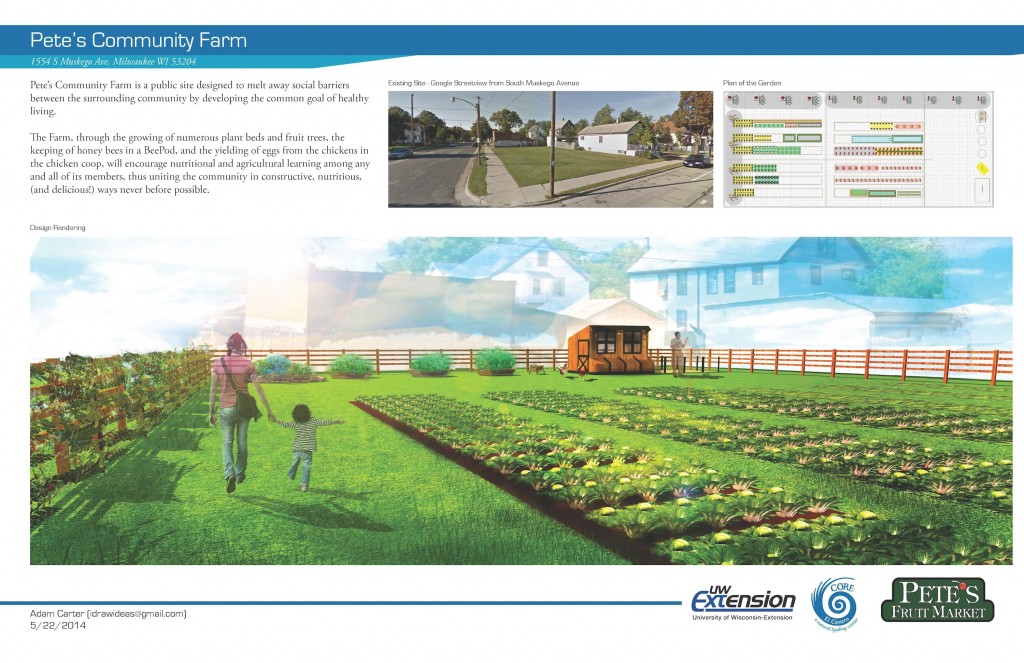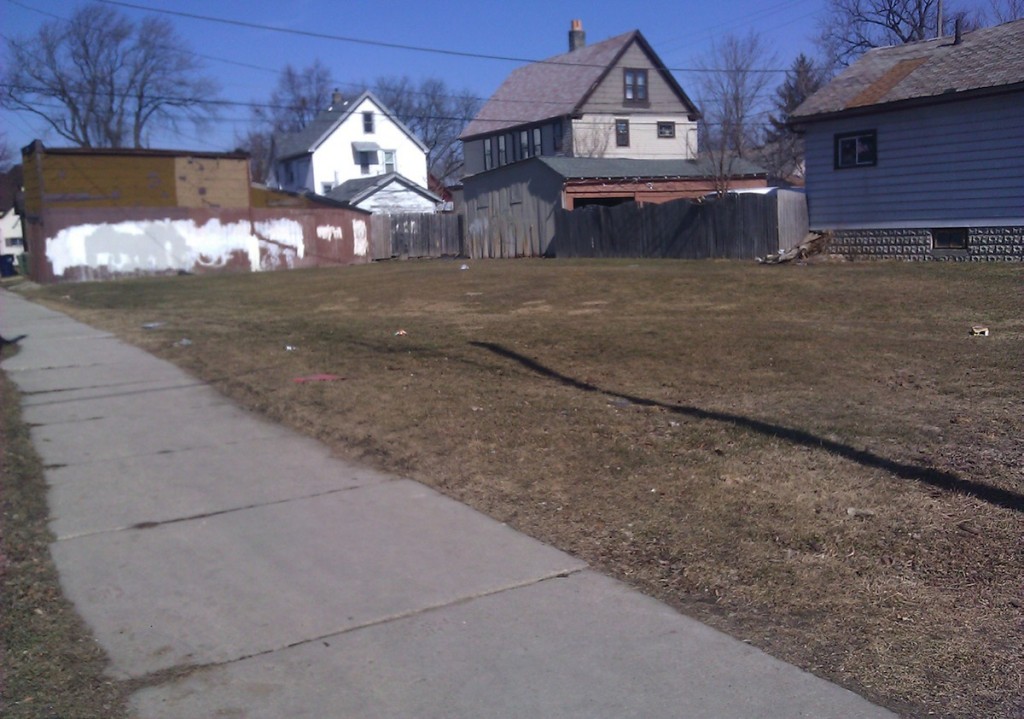Annual Report 2014-2015
Introduction
As MIAD’s Service Learning Program concludes its fourteenth year, we continue to build our relationships with our community partners and to make substantial contributions to many different sectors of the southeastern Wisconsin community. Every year we get many compliments from partner agencies on the creativity and dedication of MIAD students.
Our student’s hard work has not gone unnoticed. The Milwaukee Institute of Art & Design remains a member of the President’s Higher Education Community Service Honor Roll. The Honor Roll recognizes colleges and universities that support exemplary community service programs and best practices in campus-community partnerships.
MIAD distinguishes itself as a leader in art and design colleges by being one of the first to implement a required Service Learning Program comprising intensive courses and a minimum of 35 hours of community service per student.
During the period of time covered by this report (Summer 2014, Fall 2014 and Spring 2015), students worked approximately 4,523 hours in southeastern Wisconsin nonprofit agencies. According to research done by the Independent Sector Organization, the value of volunteer time in 2014 was estimated at $23.07 per hour. This means that over the last year, MIAD students contributed over $104,356 in volunteer labor to improve their local communities.
Aside from the impact on the community, the value of the program is what it offers to each of the students who participate. Service Learning adds a rich, hands-on component to their education. It gives them the opportunity to experience and discuss the many ways in which individuals can make a positive impact in the communities they are a part of. MIAD students are discovering previously untapped skills and revealing new components of their personalities.
As the college seeks ways to distinguish its strengths, we find that our students are increasingly making use of their Service Learning experiences to guide their professional endeavors.
A notable example from the past year was one student’s experience helping to design a community farm for the service component of the Service Learning course.
Adam Carter came into the summer 2014 course with a background in landscaping and a major in Industrial Design, both of which would be great assets in his pursuit to assist with the design of the farm.
At the time, Pete’s Fruit Market, a neighborhood staple on Milwaukee’s south side, and non-profit CORE/El Centro, had been engaging in initiatives to promote nutritious foods and healthy lifestyles to the surrounding community. They had begun a project to create an urban farm down the block from Pete’s that would raise fruits, vegetables, chickens, and honeybees.
Adam ended up creating a design rendering, plan view, and PDF presentation of the farm that CORE and Pete’s utilized in a presentation to their donors (see below image).
Stephanie Calloway, CORE’s Garden and Nutrition Program Coordinator, who initially made the opportunity available to MIAD students, explained,
“When Adam joined the project we had a grass-covered vacant lot, a few organizational partners, and a great idea. He helped us to bring the great idea into a tangible vision that we could share with community members at our first Open House. This design was also leveraged to bring in some of the initial funds for the project.”
With the collaborative efforts of all involved, “Pete’s Farm” was actualized and open by June 2014. It currently sells produce at two weekly markets, and community members come out on Wednesdays to pick their own produce. Ongoing programming continued through 2015.
Left: The vacant lot prior to the construction of the farm.
Below Right: The completed community farm as of October 2014.
Ultimately, Adam says,
“…the best part was finding out that the deliverables I produced exceeded expectations. I really wanted to do something useful for CORE and to hear that I was successful in that was simply fantastic.”
For more information about the people and organizations involved, please see the links below:
Pete’s Farm: http://petesfruitmarket.com/the-market/community-farm/
CORE/El Centro: http://www.core-elcentro.org
The Service Learning Course
HU380 is an interdisciplinary course with a service-learning component and is designed as the synthesis of a student’s four-year humanities and social science experience. Through intensive reading, writing, research and oral assignments, students analyze social issues and topics in order to evaluate how different groups and communities function and work towards resolution.
The Service Learning course topic changes periodically and is developed and taught by different members of the faculty. In addition to guiding students through their individual service experiences, each instructor introduces the students to important concepts in the humanities and the sciences. In the past year, the following courses were taught:
“Building Community”
Julia Kirchner
In this section of HU380 we will be examining how communities are constructed in different ways. Like urban anthropologists we will consider the three perspectives of physical structure, systems of social organization, and collections of attitudes and ideas. Our primary focus will be on how different spatial and cultural locations could be positively constructed as “diversity” or negatively constructed as inequality. Through our service learning component each student will use participant observation to research and discover how one non-profit agency tries to reinforce the idea of active community building.
“Plant Yourself: Connecting Food, Society, and Agriculture”
Mark Caldwell
This section of HU380 will utilize sociology as the basis for understanding issues surrounding food. Foundational theories and supplemental readings on culture, technology, organizations, the family, religion, and economics and the state will underpin our understanding of how food systems operate. This course addresses these social aspects of food production and consumption based on a historically situated approach, which shows this relationship through information known about particular periods. In addition to learning about food systems from a macro-social perspective, you will also personally engage your community and ideas at the micro-social level. Involvement will include developing real solutions to global and local food issues by situating yourselves as actors within various positions of government, finance, and farming.
2014-2015 Service Learning Placements
MIAD currently has more than 200 community partners throughout the southeastern Wisconsin area. There are many organizations with varying missions, and the faculty, supported by the Academic Service Learning Program Assistant, work with students to identify placement opportunities that will provide further enrichment of the curricular topics being explored in the course.
Following the name of each community partner listed below is the number of students who worked at that placement during the past academic year:
A.E. Burdick Elementary & Middle School 1
Artists Working in Education 3
Aurora Health Care 2
Ben Franklin Elementary School 1
Boys and Girls Clubs of Greater Milwaukee 1
Bradford High School 1
Bruce Guadalupe Community School 1
Children’s Hospital of Wisconsin 1
Coalition of Photographic Arts 1
CORE/El Centro 7
Discovery World 5
Donna Lexa Art Centers 1
Downtown Montessori Academy 1
Ebenezer Child Care Center 6
Engleburg Elementary School 1
Express Yourself Milwaukee 1
Geneva Lake Conservancy 1
Growing Power 8
Guest House 1
Habitat for Humanity 3
Happy Endings No Kill Cat Shelter 1
Havenwoods State Forest 1
Hmong American Friendship Association 1
Hoffman Estates Choir Program 1
Homestead High School 1
Hope House 1
Hunger Task Force 2
IndependenceFirst 2
Jewish Home and Care Center 1
Katie Beckett Program 1
La Causa Early Education Center 1
La Escuela Fratney 1
Lapham Peak State Park 1
Life Church 1
Marquette Childcare Center 1
Maryland Avenue Montessori School 1
Milwaukee Area Domestic Animal Control Center (MADACC) 8
Milwaukee Artist Resource Network 1
Milwaukee Bicycle Collective 1
Milwaukee Catholic Home 1
Milwaukee LGBT Community Center 5
Milwaukee Zen Center 1
Mitchell Park Horticultural Conservatory 3
Mt. Zion Wings of Glory Youth Programs 1
New Berlin West Middle & High School 1
Next Door Foundation: Books For Kids Program 1
Northwest Side Community Development Corporation 1
Parkway Church 1
Peak Nordic Ski Team 1
People’s Books Cooperative 1
The Pitch Project 1
Pius XI High School 1
Planned Parenthood 1
Riverwest Co-op 14
Riverwest Film & Video 3
St. Ann Center for Intergenerational Care 1
Sturgeon Bay School District 1
St. Vincent de Paul Society 2
Tippecanoe Presbyterian Church 1
Tree of Life 1
TRUE Skool 1
Urban Ecology Center 14
UWM Greenhouse Facilities 8
Victory Garden Initiative 1
Village Church of Bartlett 1
Vulture Space 19
Walker’s Point Center for the Arts 3
Waukesha West High School 1
Willow Creek Community Church 1
YMCA of Metropolitan Milwaukee 2
Annual Comparisons
(Listed below by Year, Number of Students, Total Hours, and Total $ Value of Labor)
2001-2002: 79, 4,878, $79,365
2002-2003: 116, 7,000, $117,180
2003-2004: 110, 6,600, $115,830
2004-2005: 123, 6,200, $111,848
2005-2006: 126, 6,300, $97,000
2006-2007: 127, 3,080, $57,800
2007-2008: 149, 3,821, $74,548
2008-2009: 131, 3,480, $70,470
2009-2010: 128, 3,937, $82,086
2010-2011: 177, 5,667, $121,047
2011-2012: 148, 5,175, $112,763
2012-2013: 156, 4,700, $104,057
2013-2014: 157, 4,021, $90,674
2014-2015: 169, 4,523, $104,356
- A total of 169 students enrolled in HS 380 over the 2014-2015 academic year.
- MIAD students served with 70 placements in our community during the 2014-2015 year.
- 34% of MIAD students served in placements related to animals, nature or the outdoors.
- 26% of students served in placements where they worked directly with children.
- 2% of students served in placements where they worked directly with people who were homeless.
- 22% of students served in placements related to health care and/or social justice.
- 14% of students served in placements related to the arts or museums.
- MIAD service learners spent 4,523 hours volunteering.
- MIAD students contributed the equivalent of $104,356 during the 2014-2015 academic year.*
Most Popular Placements
The placements that hosted 5 or more students this year are as follows:
- CORE/El Centro
- Discovery World
- Ebenezer Child Care Center
- Growing Power
- Milwaukee Area Domestic Animal Control Center (MADACC)
- Milwaukee LGBT Community Center
- Riverwest Co-op
- Urban Ecology Center
- UWM Greenhouse Facilities
- Vulture Space
Ongoing Dynamism of Service Learning: Our Website and New Partners
We know that MIAD faculty, staff, students, and alumni are involved in community service, and students’ Service Learning experiences inform and enhance their studio work. We feel our partners are an integral component of providing this learning experience to our students – we truly see this endeavor as a partnership. MIAD has the capacity and the commitment to stay engaged with its identified constituencies and communities. How better to profile this than in a website that links all involved parties?
The goals of the site are to provide direct links to our partners’ websites, and show the collaborations and highlights of the program.
Each year, MIAD welcomes new partners to its Service Learning program, either brought to us by students, or upon the request of the organizations themselves. This year, some of the new community partners who joined us and were particularly successful in providing student placements were Ebenezer Child Care Center and the Victory Garden Initiative. There are more new partnerships in progress in which MIAD is looking forward to participating in upcoming semesters.
In Conclusion
Service Learning continues to be a valuable part of educating MIAD students in active citizenship and community participation. The program introduces the public to MIAD in a positive and accessible manner and showcases our students’ valuable and diverse talents.
Our Service Learning program is unique, because it connects creative work, academic rigor and activism in the community.
We are grateful to our supporters for providing students with the opportunity to experience transformation through Service Learning.
*Pay equivalency for volunteer work used to calculate monetary value of MIAD’s service learners was based on information taken from the website cited below. The site states that the estimated value of volunteer time for 2014 was $23.07 per hour. (www.independentsector.org)


